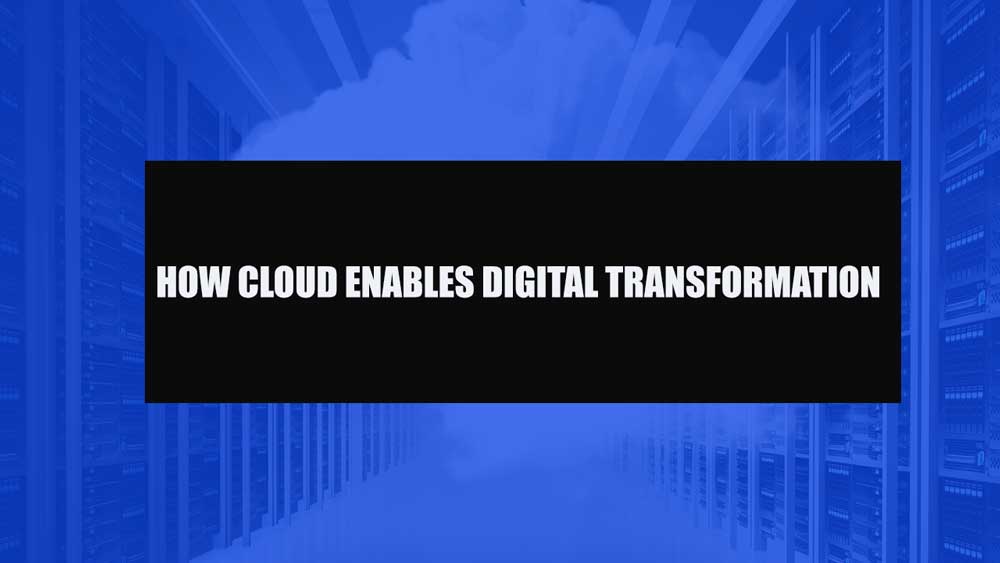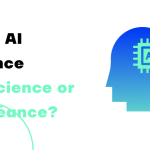How Cloud Enables Digital Transformation Success.
‘Digital transformation’ is the new buzzword for companies trying to revolutionize their operations in today’s fast-moving and highly competitive digital environment. Both small scale and large scale companies are updating their non-digital and manual processes with new technology like AI, machine learning, robotic process automation (RPA), and hyper-automation. Customer experience solutions are utilizing data coming in from social media, mobile, the Internet of Things (IoT), as well as a whole host of other consumer apps. This revolution is only possible because of the Cloud, which can help companies collect, transform, and analyze data in near real-time, which is a necessity in today’s demanding customer experience environment.In 2021, we can safely say the mass marketing experience – or experiment, as some see it – is over. Wanamaker’s lament that half of his advertising money worked but he didn’t know which half is a problem of a bygone era. Attribution is attainable now. This is a time when companies can surgically strike offers to a market of one rather than blast a shotgun of offerings to an uninterested many, making their offers much more likely to be used. However, this kind of marketing precision and ensuing attribution doesn’t come easy or without a lot of computing power behind it. The cloud allows for the quick implementation and rollout of APIs, a powerful tech backbone for highly sophisticated analytics platforms, Big Data repositories for the collection of massive amounts of data, and a tight privacy and security framework that is far stricter than what many private clouds or onsite IT estates can provide.
What is the Cloud?
In August 2006, Eric Schmidt spoke at the Search Engine Strategies Conference, predicting the standard client/server computing business model would soon be replaced by a new model he dubbed ‘cloud computing’. The servers would be in a ‘cloud’, Schmidt claimed, and these would be accessible by the right kind of browser or the right kind of access. As CEO of Google at the time, Schmidt saw advertising as the department most needing cloud computing, but today almost every department in a large-scale organization taps into data residing in the cloud. It is now being used as a hosting site for applications handling CRM, digital marketing, analytics, and software as a service solution, as well as for disaster recovery sites, or as basic data storage repositories.Today, the advantages of using the cloud – cost, scalability, the ability to turn on and turn off servers at will, energy savings – often far outweigh the disadvantages of not having data housed on a server locally.As Google sees it, “In the modern cloud, customer experiences, business models, data strategy, innovation, and employee culture and productivity can all be reimagined in ways that lead to meaningful revenue growth. In fact, it’s fair to say that no aspect of the business is left untouched by this transformation.” The cloud allows companies to scale infrastructure as needed to support changing business priorities.
Digital Transformation
‘Digital transformation’ is a catchall for the process of revolutionizing a company’s IT department. In his article Five Steps To Starting Your Digital Transformation Initiative, R ‘Ray’ Wang says regardless of industry, size of the company, or geography, early digital transformation adopters share the five following common steps to ensure success:
- Designing new experiences and business models
- Developing a culture of digital DNA
- Applying new technologies to existing infrastructure
- Moving from gut to data-driven decisions
- Co-creating and co-innovating with new partners
R ‘Ray’ Wang believes a digital transformation should be used as an opportunity to craft new customer experiences. ‘Experience’ is a term being used by software companies to market their CRM and digital marketing automation products and customers are certainly seeking strong and personally satisfying experiences with the companies they patronize, but the gap between expectations and delivery only gets exacerbated in the digital world. The concept of “Personalization” has become so prevalent today it’s common to see companies utilize geolocation, mobile app, social, contextual, and even behavioral data in their marketing messages, which also much be happening in real-time.In its Creating the Single Customer View with Adobe Campaign, the Adobe Experience Cloud team recommends businesses utilize sales-centric campaign management tools that use real-time data to engage customers in both behavioral and contextual ways. Adobe believes, businesses will be hard-pressed to create the all-important single customer view without real-time data. “If you can’t capture the granular details surrounding customer interactions — if you can’t understand the data you do have — it’s virtually impossible to deliver personalized experiences at scale and build a loyal customer base,” warns Adobe. Personalization at scale is practical only when delivered on the cloud.
Hitechies Podcast
The Hitechies Podcast provides exposure and support to millions of interesting technology startups worldwide. We are a fast-growing Tech Podcast with over 30k downloads a month. We have created a special startup segment where we feature innovative and interesting startups trying to solve worldly problems. We publish articles, opinions, and interviews that provide better insights. I
Listen On Spotify
Listen
Successful digital business models reinforce the brand as well as promote the overall brand mythology, Wang says. “The shift to a sense and respond model requires a new design point. Mass personalization at scale, big data business models, and augmented humanity provide a starting point to designing a new digital experience, Wang argues.For Wang, success not only begins at the top but it’s highly diversified. Developing the digital culture requires strong leaders who don’t look out for short-term goals, but rather have a long view. An honest appraisal of the organization’s personnel is also required. A healthy mix of quant jocks who deliver hard science and engineering prowess should be balanced out with creatives who can innovate and implement across the digital terrain, says Wang. In an organization with too many thinkers, Wang recommends balancing out the model with teams who can execute. “Using a framework for digital proficiency and a checklist on digital artisans, organizations can infuse digital DNA throughout the culture,” Wang advises.Applying new technologies to existing infrastructure doesn’t necessarily mean a sweeping replacement of existing technologies is needed, according to Wang. Slapping on a new mobile front end or adding a social collaboration feature to a current process isn’t that useful either, says Wang. “The convergence of mobile, social, cloud, analytics (big data), and unified communications provide starting points,” contends Wang. Adding IoT sensors to old machinery can provide data and context, while building models on mainframe data can provide new insight as well as new opportunities with legacy data, argues Wang. Adding social and contextual data to personalization marketing can strengthen the customer-company loyalty bonds. The digital transformation should be a time to rethink a company’s technology strategy so that it can be aligned with the most important business objectives, says Wang.Applying new technologies to existing infrastructure doesn’t necessarily mean a sweeping replacement of existing technologies is needed, according to Wang. Slapping on a new mobile front end or adding a social collaboration feature to a current process isn’t that useful either, says Wang. “The convergence of mobile, social, cloud, analytics (big data), and unified communications provide starting points,” contends Wang. Adding IoT sensors to old machinery can provide data and context, while building models on mainframe data can provide new insight as well as new opportunities with legacy data, argues Wang. Adding social and contextual data to personalization marketing can strengthen the customer-company loyalty bonds. The digital transformation should be a time to rethink a company’s technology strategy so that it can be aligned with the most important business objectives, says Wang.Unsurprisingly, data is the centerpiece of any digital transformation. Every touch point, every clickstream, every interaction provides a digital footprint rich in context. “The goal is to move from right time information overload, to real-time contextual relevancy,” argues Wang, adding, “Organizations need relevancy delivered in real time.” No matter how generous the mobile coupon, if a customer receives it in the right place at the wrong time or in the wrong amount, it will go unused, while also being a waste of both time and money for the marketer. “From asking the right questions to anticipating future behavior, the goal is to move from data to decisions. Every bit of data flows into upstream and downstream information aligned with business processes,” says Wang. All of this information allows the company to provide data-driven insight to its executives, employees, and even, if need be, its customers.Nature abhors a vacuum, as Aristotle once proclaimed, as does innovation. Wang recommends companies participate in industry consortiums while creating ecosystems that embody the organization’s self-interest. Innovation doesn’t have to be kept in-house either. Setting up blogs or innovation zones that allow customers to comment on a company’s products and services can also be a good way to gain customer feedback and, who knows, it could result in some new product offerings.
Digital Transformation
Digital transformation can help personalize the customer experience in a multitude of ways. Great customer service begins with the recognition of a customer and this can be accomplished by setting up a geo-fencing app that spots a customer entering a location then sending out an offer. Facial recognition and video analytics technology can make a customer’s experience more memorable than it would have been without deeply personalized service. Customer service via digital social media helps customers connect via the channels they use and prefer. Chatbots can also automate customer service requests, as well as seamlessly disseminate information.A digital-first company can get more accurate attribution analysis information so that the company can understand which advertising is associated with which user. This makes the advertising much more quantifiable and actionable. The number of promotions available and the number of channels to market them through increases as campaign lift is quickly understood.Customer acquisition can also be rapidly accelerated because business users throughout a company can quickly derive answers to questions like, ‘which product features do users like or dislike?’, ‘what features drive adoption and/or renewal?’, and ‘what behavior signals churn?’. Customer clickstream data can rapidly be turned into profitable business opportunities, while powerful recommendation engines can ingest data from multiple sources, analyze it, and then make it available to a company’s frontline staff, who can use it for real-time market basket analysis, recency-frequency-monetary (RFM) initiatives, or even reducing customer churn.
How Cloud enables Digital Transformation.
In 2006, Eric Schmidt said a cloud revolution was coming. He knew it was going to revolutionize marketing departments first and foremost because cloud technology allowed for the rapid collection and dissemination of data. Today, every customer-facing company needs to be a digital-first company so it can get more accurate attribution analysis and better patron behavioral data that helps create deeper customer understanding. Being digital-first and data-driven will help companies build more accurate supply chain analysis, provide a better labor environment as well as create stronger forecasting models. All of these things might be possible with a normal customer-based IT estate, but it will be simpler and much more effective if it is on the cloud. “On the modern cloud, managed services abstract away underlying infrastructure, letting users and operators think in terms of familiar work semantics (jobs, queries, datasets), rather than underlying resources (servers, networks, databases),” says Google. This new approach both resets assumptions and allows users to focus on what humans do best – creativity.“By building a digital backbone that extends from bare-metal servers all the way through the global IoT network to mobile (and other) consumer-facing surfaces, the modern cloud creates opportunities to rethink how customers and partners experience and interact with” a company’s products and services, says Google.The cloud enables digital transformation to become successful. It allows a company to get powerful computational resources at the push of a button, at cost-effective prices. It allows companies to ramp systems up or down as needed, as well as scale massively, if need be. With the coming IoT data deluge, cloud will be a requirement not a necessity. Having a data-driven organization is imperative in today’s world of real-time data and highly demanding customers who expect companies to be available 24 hours a day, seven days a week, 365 days a year. Contrary to one’s first expectations, putting your faith – and data – in the cloud, might be one of the most concrete, secure, and cost-effective things an IT department can do.









